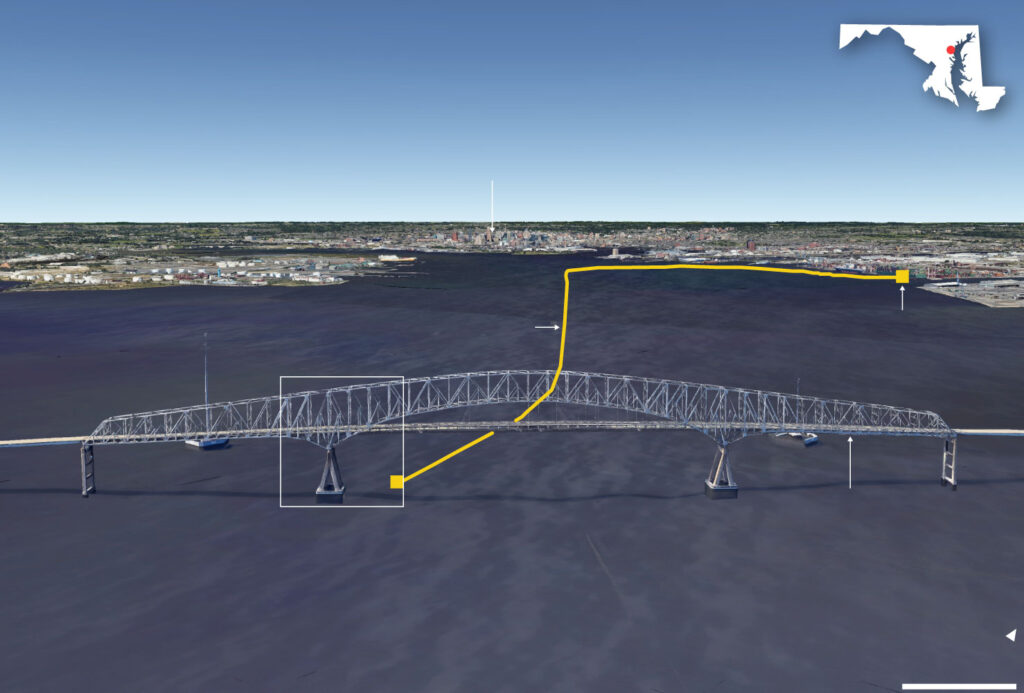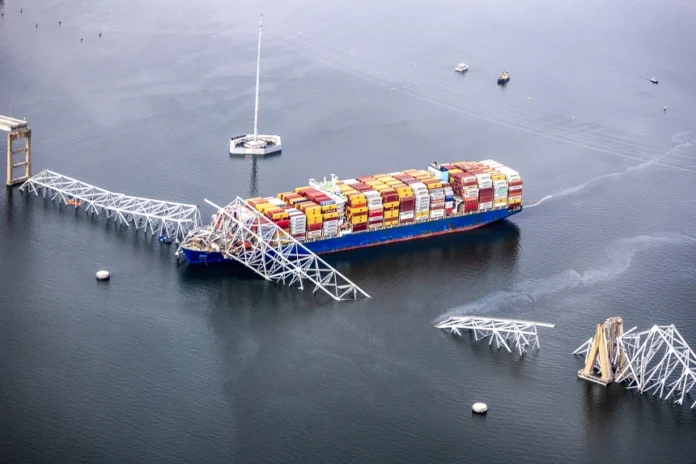The cargo ship crash into the Francis Scott Key Bridge in Baltimore has left a devastating impact on the city and its residents. The collapse of the bridge has not only caused physical destruction but has also shattered the sense of security and stability that the bridge once represented. The incident, which occurred early Tuesday morning, has sent shockwaves throughout the community as they grapple with the loss of six individuals who are now presumed dead.
As news of the tragedy spread, the city quickly mobilized search-and-rescue teams to locate any survivors trapped in the wreckage. However, as time passed and the extent of the damage became apparent, hope began to fade. The immense force of the container ship colliding with the bridge caused it to disintegrate, plunging large sections into the dark waters below. The once bustling bridge, which connected neighborhoods and served as a vital transportation route, now lay in ruins.
Despite the efforts of the search-and-rescue teams, officials have now made the difficult decision to transition their operation from a rescue mission to a recovery mission. The chances of finding any survivors have been greatly diminished due to several factors. Firstly, the water temperature in the area is quite cold, making survival in the water for an extended period highly unlikely. Secondly, the time that has passed since the collision has further reduced the chances of finding anyone alive.
The impact of this tragic incident extends beyond the loss of life. The Francis Scott Key Bridge was not only a vital transportation link but also a symbol of the city’s resilience and connectivity. Its collapse has disrupted the daily lives of countless individuals who relied on the bridge for their commutes, businesses, and social activities. The sudden absence of this crucial infrastructure has caused significant disruptions and forced residents to find alternative routes and means of transportation.
Furthermore, the collapse of the bridge has raised concerns about the safety and structural integrity of other bridges in the area. Engineers and city officials are now evaluating the condition of nearby bridges to ensure that similar incidents do not occur. This incident serves as a stark reminder of the importance of regular inspections and maintenance to prevent such catastrophic events from happening in the future.
The Baltimore community is now left to mourn the loss of the six individuals presumed dead in this tragic accident. Vigils and memorials have been organized to honor their lives and provide support to their grieving families. The impact of this incident will be felt for years to come as the city works to rebuild not only the physical infrastructure but also the trust and sense of security that has been shattered by this devastating event.
As the news of the bridge collapse spread, shock and disbelief gripped the nation. The tragic chain of events had unfolded rapidly, leaving a trail of destruction in its wake. The cargo ship, Dali, had been sailing through the calm waters when it suddenly lost power. The crew’s desperate mayday call echoed through the air, a plea for help in the face of impending disaster.
Within moments, the massive vessel collided with a bridge support, the impact reverberating through the structure. The force of the collision was enough to cause the bridge to buckle and collapse, sending shockwaves of panic and chaos throughout the area. Maryland Governor Wes Moore wasted no time in declaring a state of emergency, mobilizing rescue crews to the scene.
As the rescue efforts commenced, the true extent of the tragedy became apparent. Submerged beneath the frigid, 50-foot-deep water were at least five vehicles, their occupants now trapped in a watery grave. The vehicles included three passenger cars, a cement truck, and another unidentified vehicle. The chilling reality dawned that lives had been lost, families torn apart by an unforeseen catastrophe.
Authorities, while grappling with the enormity of the situation, held on to a glimmer of hope. Preliminary investigations suggested that there might not have been anyone inside the vehicles at the time of the incident. While this offered a small measure of solace, it did little to alleviate the grief and anguish that had descended upon the community.
As the investigation into the cause of the collision unfolded, one thing became clear: this was an accident, not an act of terrorism. The Dali, the vessel at the center of this tragedy, had a previous collision on its record. In July 2016, it had been involved in an incident at the port of Antwerp-Bruges in Belgium. However, details of that particular event were shrouded in uncertainty, leaving investigators with more questions than answers.
The Dali, operated and managed by Synergy Group, had a crew of 22 members on board. Miraculously, all of them had been accounted for, escaping the clutches of the sinking ship. The crew’s survival was a testament to their training and quick thinking in the face of adversity.
As the investigation continued, the impact of the bridge collapse rippled beyond the immediate tragedy. Danish shipping giant Maersk, which had chartered the Dali, now faced the daunting task of redirecting its ships to other nearby ports. The closure of the Port of Baltimore, a crucial hub for commerce, would have far-reaching implications for the shipping industry and the economy as a whole.
Rebuilding and Recovery
President Joe Biden has pledged federal funds to rebuild the collapsed bridge and reopen the port. However, he cautioned that the process will take time and urged the people of Baltimore to be patient. Transportation Secretary Pete Buttigieg echoed the president’s promise, emphasizing the significance of the bridge as a vital piece of American infrastructure. Replacing the bridge and reopening the port will require substantial time and financial resources, which could impact supply chains.
The Port of Baltimore is the 11th largest in the United States and serves as a crucial hub for car imports and exports. In 2023 alone, it handled over 750,000 vehicles, according to data from the Maryland Port Administration. The closure of the port will have significant economic implications, particularly for those whose livelihoods depend on the shipping industry.
With the closure of the port, businesses that rely on the import and export of goods will face numerous challenges. The interruption of supply chains can lead to delays in receiving essential materials and products, affecting manufacturing processes and potentially causing shortages in the market. Companies that depend on the port for their operations will need to find alternative routes and transportation methods, which could result in increased costs and logistical complexities.
Moreover, the closure of the port will have a ripple effect on the local economy. The shipping industry supports a wide range of jobs, from dockworkers and truck drivers to warehouse employees and administrative staff. The temporary halt in port operations will directly impact these workers, potentially leading to layoffs and financial hardships for many families in the Baltimore area.
Additionally, the closure of the port will affect other sectors of the economy that rely on the smooth functioning of the shipping industry. Local businesses, such as restaurants, hotels, and retail stores, may experience a decline in customers and revenue as the flow of goods is disrupted. The tourism sector, which often benefits from the presence of a bustling port, may also suffer as fewer visitors are drawn to the area due to the ongoing reconstruction efforts.
Given the significant economic implications, it is crucial for the federal government, state authorities, and local stakeholders to work together to expedite the rebuilding process. The allocation of federal funds is an important step, but efficient project management and coordination will be equally vital. The government must ensure that the necessary resources and expertise are mobilized to complete the bridge reconstruction and port reopening as quickly as possible.
Once the bridge is rebuilt and the port reopens, it will be essential to implement measures that enhance the resilience of the infrastructure. This could involve incorporating new technologies and engineering solutions to withstand future natural disasters or unforeseen events. Additionally, investing in alternative transportation routes and diversifying the region’s economic activities can help mitigate the impact of any potential future disruptions.
Overall, the rebuilding and recovery process following the collapse of the bridge and the closure of the Port of Baltimore will require a comprehensive approach that addresses the immediate challenges while also laying the foundation for a more resilient and sustainable future. By prioritizing the restoration of this vital piece of infrastructure, the government can not only support the local economy but also ensure the smooth functioning of the national supply chain network.
In addition to the immediate tragedy and loss of life, the explosion at the port of Baltimore has far-reaching implications for the city and its residents. The port serves as a vital economic artery, supporting thousands of jobs and businesses that rely on its operations. With the port temporarily shut down for investigations and cleanup, these individuals and companies face significant financial hardships.
The impact extends beyond just the workers and businesses directly connected to the port. The port’s closure disrupts the entire supply chain, affecting industries such as manufacturing, retail, and transportation. Companies that rely on imported goods or export their products through the port now face delays, increased costs, and potential losses. This disruption could have a ripple effect on the city’s economy, leading to job losses, reduced consumer spending, and a downturn in overall business activity.
Furthermore, the incident raises serious questions about the resilience of the city’s infrastructure and the need for robust safety measures. The explosion at the port highlights the potential vulnerabilities in critical infrastructure systems, such as storage facilities and transportation networks. It underscores the importance of regularly assessing and upgrading these systems to ensure their safety and reliability.
Local and national authorities must now undertake a comprehensive review of the safety protocols and regulations governing port operations. They need to identify any gaps or weaknesses in the current system and implement measures to prevent similar accidents in the future. This process requires collaboration between government agencies, industry stakeholders, and safety experts to develop and enforce stricter safety standards.
Moreover, the incident serves as a wake-up call for the entire nation to prioritize infrastructure investment and maintenance. The port of Baltimore is just one example of the many aging and potentially vulnerable infrastructure systems across the country. Neglecting these systems not only puts lives at risk but also hampers economic growth and national security.
It is crucial for policymakers to allocate sufficient resources to upgrade and maintain critical infrastructure, including ports, bridges, roads, and railways. This investment will not only enhance safety but also create jobs and stimulate economic activity. Additionally, incorporating advanced technologies and sustainable practices into infrastructure projects can help build more resilient and efficient systems for the future.
In conclusion, the explosion at the port of Baltimore has significant implications for the city and its residents. The immediate impact on jobs and businesses is substantial, and the disruption to the supply chain affects various industries. The incident also highlights the need for improved safety measures and infrastructure resilience. It calls for a comprehensive review of safety protocols and increased investment in infrastructure to prevent future accidents and ensure long-term economic growth.


